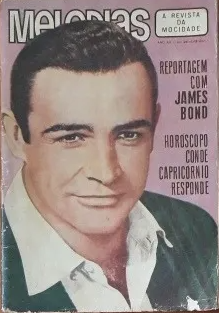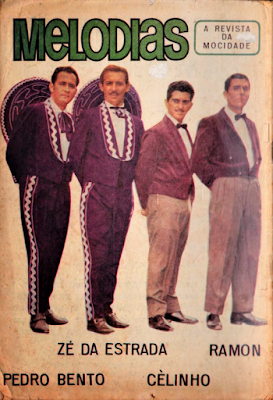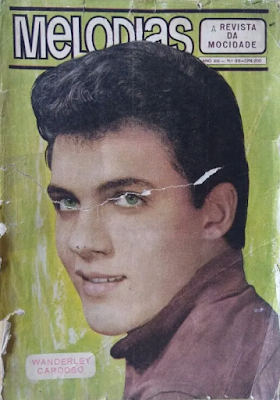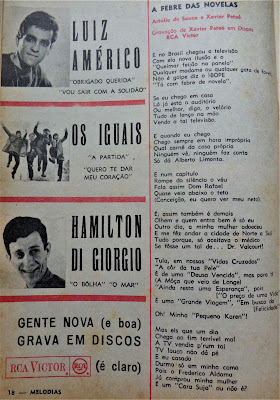As of issue # 95, of June 1965, 'Melodias' changed its physical format. It became a little smaller and most conspicuously it was printed in off-set. Was it a better magazine? Hardly! I actually preferred their old look. The new off-set printer probably wasn't state-of-the-art so the pages had a besmirched look I really hated. The photos were even worse. I wish I had inside-information about what really happened at Editora Prelúdio's management-decision level. Why did they change the magazine format to something worse?
Apart from its look 'Melodias' remained basically the same: 2 thirds pop and the last third dedicated to rural music aka Sertanejo and its business. 'Melodias' was a typical Paulista publication when the bulk of Brazilian show business happened in and around São Paulo. Most novelas (Brazilian soap operas) were made in either TV Excelsior, Channel 9 or TV Tupi, Channel 4. Most musical programmes were made by TV Record, Channel 7.
TV Paulista, Channel 5, was in a minor league but could also be a trend-setter like the rock-shows devised by DJ Antonio Aguilar who ended up being co-opted first by TV Excelsior and then by TV Record. Comic shows like Manoel da Nobrega's 'Praça da Alegria' was started at TV Paulista and later poached by the more affluent broadcaster.
São Paulo was the home of the Sertanejo (rural music) even though Minas Gerais was a strong competitor. 'Melodias' made a point of getting a Sertanejo act on the back-cover while a pop act was always on the cover but with the greater popularity of the new Brazilian-rock aka 'Jovem Guarda' 'Melodias' did the unthinkable: as of issue # 104, April 1966, rural music lost its place on the back-cover with the splashing of Wanderlea's face on it. Gradually, rural music which used to take up one-third of the magazine was demoted to only one-fifth of it.
From mid-1963 up to 1968, São Paulo was also the vanguard of Italian music due to its quantity of Italian immigrants that settled in the state since the late 1880s. 'Melodias' always had a page dedicated to Italian lyrics and news.
Don't forget São Paulo led in the MPB (Brazilian pop music aka Bossa Nova) department too. Due mainly to the indefaticable work of DJ Walter Silva who produced huge concerts of Bossa Nova at Theatro Paramount, recorded them live and released albums through RGE - 'O Fino da Bossa' being the 2nd best selling album in Brazil in 1964 - he created a vibrant market that eventually spilled into mega MPB Festivals that were mainstream up to the end of the 1960s.
# 95, June 1965 - Amilton Fernandes as Dr. Albertinho Limonta & Isaura Bruno as Mamãe Dolores in TV Tupi's production of a 1946 original radio-drama by Cuban author Felix Caignet's 'O direito de nascer' (El derecho de nacer) which ran from 7 December 1964 through to 13 August 1965; on the back-cover: Zé Fortuna, Pitangueira & Zé do Fole.
# 95, June 1965 - This is how the new 'Melodias' looked like. Columnist Salvador Buonaerba had a 2nd photo opportunity besides Rita Pavone who visited Brazil for the 2nd time, in late April 1965. Actually if you look hard you'll notice Pavone is holding issue #94 of Melodias in which she's at the cover. According to the column these were the best-selling singles in Italy some weeks (or months) before: 1. 'Non son degno di te' (Gianni Morandi), 2. E adesso te ne puoi andare (Les Surfs), 3. 'La mia festa' (It's my party) with Richard Anthony, 4. 'Cristina' (Bobby Solo), 5. 'Per un pugno di dollari' (Ennio Morricone), 6. 'L'amore mio' (Rita Pavone).
# 95, June 1965 - Singer-song-writer cum radio-man Zé Fortuna (José Fortuna) & Pitangueira (his brother Euclides Fortuna) aka Os Maracanãs, open their houses in Tucuruvi to show their fans at Melodias. Both brothers were born in Itápolis-SP.
# 97, August 1965 - TV's Silvio Santos first Melodias cover. He would grace its cover many a-time; Pedro Bento & Zé da Estrada + Ramon & Celinho.
# 98, October 1965 - Elis Regina, the great new sensation; Paixão & Pachola.
# 98, October 1965 - In less than 18 months Elis Regina (*17 March 1945 +19 January 1982) went from complete unknown to queen of the pop's. Since Elis sang Edu Lobo's 'Arrastão' at TV Excelsior's 1964 Song Festival, she went from strength to strength. By mid-1965, Elis & Jair Rodrigues' 'Dois na Bossa', a live album recorded from 3 recitals they gave at Teatro Paramount on 25 May 1965, was the best-selling album in the country. Walter Silva was the producer of both show & recording. When TV Record realized Elis was a gold mine they signed her to appear on the small screen in a programme called 'O Fino da Bossa'. It started on 19 May 1965, exactly 18 days after Rita Pavone had stepped on that same stage for her 2nd Brazilian tour. It was recorded live on Mondays, broadcast by Radio Panamericana and presented on Wednesdays at 7:40 pm on TV Record and TV Rio.
# 98, October 1965 - Since mid-1963, Brazil had been exposed to European records. First came the Italians with Nico Fidenco, Emilio Pericoli, Sergio Endrigo, Rita Pavone. Then, in 1965,came the French like Alain Barrière, Dalida, Christophe and the British with the Beatles, Dave Clark Five, Peter & Gordon, the Rolling Stones and their American cousins Beach Boys, Byrds etc. Brazilian charts soon mirrored this new trend, so 'Melodias' signed columnist Waldir Santos to keep their readers abreast of what was happening elsewhere. Waldir printed top-five-lists of best selling records in countries such as Argentina, UK, USA, Germany, Italy, France, sometimes Spain and Mexico. 'Melodias no Mundo' (Melodias in the World) began at issue 94, May 1965. This was its 4th month. See Argentina where Roberto Carlos is #4 with 'Mi cacharrito' (Road hog) sung in Spanish; # 1 in Argentina is 'Ho capito che ti amo' with Luigi Tenco who would kill himself in 2 years; Cliff Richard sang 'Es war keine so wunderbar wie Du' in German; in Italy, Petula Clark sang 'Ciao, ciao' a cover of 'Downtown'. All of a sudden, it seemed, the world was become smaller.
# 98, October 1965 - Radio-journalist Coripheu de Azevedo Marques (born on 20 May 1907) died suddenly on 29 August 1965. He had been a ground-breaking radio newsman who presented 'O Grande Jornal Falado Tupi' from 10:00 pm to 10:55 pm and 'Matutino Tupi' from 7:00 am to 7:55 am from Monday through Friday. He had been a Communist Party member since the early 30s and had deep knowledge of the social inequalities of his countrymen. Not long after his death, his name was given to the old Estrada de Cotia which linked Butantã to Osasco and beyond.
# 99, November 1965 - Wanderley Cardoso; Silveira & Silveirinha at the back. These were the main songs printed: 'Abraça-me forte' (W.C.), 'Como te adoro menina' (Quiereme mucho)(Ed Wilson), 'Foi assim' (Wanderlea), 'O mundo', 'O neguinho e a senhorita' (Jair Rodrigues), 'Parei, olhei' (R.C.), 'Pedro pedreiro' (C.B.H.), 'Pica pau' (E.C.), 'È l'uomo per me' (Mina), 'L'uomo che non sapeva amare' (Nico Fidenco), 'I feel fine' (Beatles), 'Dance on, little girl' (Paul Anka) & 'There's a place' (Beatles).
# 99, November 1965 - actor Carlos Zara marries TV advertising-girl Meire Nogueira at Igreja Nossa Senhora do Carmo at Rua Martiniano de Carvalho, 114 on 22nd October 1965. Agnaldo Rayol sang Gounot's 'Ave Maria' at church and São Paulo's mayor Faria Lima was there too.
# 99, November 1966 - Hermínio Bello de Carvalho's musical play 'Rosa de Ouro' opens at Teatro Oficina after a popular season in Rio. It revived the career of 1930s recording artist Aracy Cortes and introduced Clementina de Jesus to the world. Young talents Paulinho da Viola and Elton Medeiros joined Nelson Sargento for sheer brilliance.
# 100, December 1965 - Maria Bethania who substituted Nara Leão in João do Valle & Zé Keti's 'Opinião' reached #1 in the charts with 'Carcará' and was signed by TV Record.
# 102, February 1966 - Os Vips; Cascatinha & Inhana in the back-cover.
# 102, February 1966 - 1950s sertanejo recording stars Cascatinha & Inhana still had a faithful following no matter what they did.
# 102, February 1966 - Columnist Ademar Dutra presents 1965's 100 best selling records.
# 102, February 1966 - Editorial trying to explain to teenagers who wrote to the magazine complaining about older columnists who criticize young people's atittude. Lyrics of:'Ho capito che ti amo' (Luigi Tenco), 'Se non avessi più te' (Gianni Morandi), '500 miles' (Peter, Paul & Mary), 'A garota do baile', 'Mexericos da Candinha' (Roberto Carlos), 'Zambi' (Elis Regina), 'Alguém na multidão' (Golden Boys), 'É tempo do amor' (Wanderléa).
# 103, March 1966 - Agnaldo Rayol; Barrinha & Garoa
# 103, March 1966 - DJ Barros de Alencar's daily 'Só Sucessos' at Radio Tupi was probably the most popular radio show in São Paulo. Alencar who was a singer in his own right promoted huge bashes at cinemas around the city, this time at huge Cine Piratininga. Roberto Carlos, Erasmo Carlos, Jerry Adriani, Silvio Santos and Wanderley Cardoso among others were there.
# 103, March 1966 - Chico Viola Awards for best selling records of 1965. TV Record had the best musical programmes in Brazil: rock'n'roll's 'Jovem Guarda' on Sunday avo and bossa nova's 'O Fino da Bossa' on Mondays were on top of the heap. Roberto Carlos for 'Não quero ver você triste'; Jerry Adriani got the trophy in lieu of Bobby Solo for 'Se piangi, se ridi'. Ary Toledo for 'Pau de arara'; Os Vips for 'Emoção'; Erasmo Carlos for 'Festa de arromba'; Agnaldo Rayol for 'O princípio e o fim', cover of Alain Barrière's 'Ma vie' and Altermar Dutra for 'Oferenda'.
# 103, March 1966 - Jair Rodrigues got his Chico Viola for the best-selling album of 1965: 'Dois na Bossa'; Francisco Petrônio for 'Baile da saudade'; Wanderley Cardoso in lieu of Jimmy Fontana for 'Il mondo' and Zimbo Trio as best instrumental group and their album 'Zimbo Trio' and 'O fino do fino'; on the right side: Os Vips 1966 release 'A volta' which sold even more than 1965's 'Emoção'.
# 104, April 1966 - Erasmo Carlos had a #1 record with 'Festa de arromba' in 1965, and was one-third of the troika who commanded rock show 'Jovem Guarda' on TV Record every Sunday avo.
# 104, April 1966 -
# 104, April 1966 - Os Incríveis: Risonho, Nenê, Netinho, Mingo & Manito; Agnaldo Rayol & Elizeth Cardoso; Elis Regina; Jair Rodrigues, Vicente Leoporace, Zilda Cardoso etc.
# 104, April 1966 -
# 104, April 1966 -
# 105, May 1966 - Wanderley Cardoso on the cover of 'Melodias' for the 2nd time; best selling singles of March 1966: 1. 'Quero que vá tudo p'ro inferno' (Roberto Carlos), 2. 'Yesterday' (Matt Monro), 3. 'A praia' (La playa) with Agnaldo Rayol, 4. 'Michelle' (Billy Vaughn), 5. 'A volta' (Os Vips); best selling album: 1. 'Jovem Guarda' (R.C.), 2. 'Help' (The Beatles), 3. 'Quando o amor te chama' (Agnaldo Rayol), 4. 'Whipped cream & other delights' (Herb Alpert), 5. 'Isto é Renato & seus Blue Caps'.
# 105, May 1966 - The Jordans while touring Europe.
# 105, May 1966 - 'Melodias' couldn't deny it was a São Paulo publication; it trumpeted to the whole country: 'Brás has acclaimed Roberto Carlos'. Brás is a São Paulo inner suburb in which Cine Universo, the largest movie theatre in town was let one Sunday morning (17 April 1966) to congragate a large crowd to celebrate of Roberto Carlos' 25th birthday.
# 105, May 1966 - Os Vips, brothers Ronald Luiz, 22 years old (*17 August 1943) & Marcio Augusto Antonucci, 20 (*23rd November 1945) were high in the charts with 'A volta' their follow-up to 'Emoção', both tunes written by Roberto Carlos-Erasmo Carlos.
# 105, May 1966 - Italian most popular male singer Gianni Morandi visits Brazil, performing at TV Tupi. Even though the crest of the Italian-music wave decreased Morandi was in the charts with 'Si fa sera'.
# 106, June 1966 - Agnaldo Rayol is on Melodias cover again, this time with Roberto Carlos; showing times were changing fast, Melodias does not put a Sertanejo artist on its back-cover; instead Francisco Petrônio takes its place.
# 106, June 1966 - By mid-1966, the Italian wave had visibly abated; Brazilians had turned their eyes to themselves & their home-made idols like Roberto Carlos, Elis Regina, Jair Rodrigues etc. Differently from Argentina whose best selling single was Caterina Caselli's 'Nessuno mi può giudicare' (#1 in Italy as well) Brazilians were left cold by those new Italian hits.
# 107, July 1966 - Tony Campello & wife Therezinha Sodré's son Marcelo Campello in an article by Fred Jorge who traveled to Taubaté-SP to visit the Campello Family.
# 108, August 1966 - Jair & Elis.
# 108, August 1966 - Elis Regina & Jair Rodrigues were still really popular being on TV every Wednesday night with 'O Fino da Bossa' which started more than a year ago on 19 May 1965.
# 108, August 1966 - Os Incríveis on the back-cover of Melodias' Elis-Jair edition.
# 109, September 1966 - Spanish dancer turned rock'n'roller Orlando Alvarado + Geraldo D'El-Rei.
# 109, September 1966 - Jorge Ben née Jorge Meneses was unique when it came to allegiance and fealty. Ben's first album 'Samba esquema novo', released by Philips in 1963 was a phenomenal success. It felt like Bossa Nova but it was not exactly Bossa Nova so after a while Jorge was snubbed by those who claimed to be the real B.N. people. He was invited to perform at 'O Fino da Bossa' and while at Teatro Record he bumped into Roberto Carlos, an old acquaintence from Barra da Tijuca teenage-days who had just started his rock-show 'Jovem Guarda' which was anathema for those who followed B.N. Roberto invited his old friend Jorge to perform at 'Jovem Guarda' which would make him more enemies at the 'other side' of the spectrum... but Jorge went ahead and did it.
# 109, September 1966 - Song-writer Tuca, a complete unknown won TV Excelsior's 2nd MPB Festival with 'Porta estandarte' written by Geraldo Vandré and Fernando Lona. Tuca sang it with percussionist Airto Moreira but ended up recording the tune with Vandré.
# 110, October 1966 - Angela Maria & Ronnie Von.
# 111, December 1966 - Wanderlea finally makes to the cover of Melodias; Dick Danello in costume for a photo-romance.
# 111, December 1966 - Geraldo Vandré is the man of the hour, after having won TV Record 1966 Song Festival with 'Disparada', on 10 October 1966.
# 111, December 1966 - Chico Buarque's 'A banda' was the best-selling single in the land followed by 2. 'Disparada' (Jair Rodrigues), 3. 'A banda' (Nara Leão), 4. 'Meu bem' (Girl) with Ronnie Von; 5. 'Esqueça' (Forget him) with Roberto Carlos. As one could see MPB (Brazilian pop music) was vying with Jovem Guarda (Brazilian rock) for superiority by the end of 1966. Best-selling E.P. was 'California dreamin' by the Mamas & Papas while the sound-track of 'Dr Jivago' by Maurice Jarre was the best-selling lbum in the land.
# 111, December 1966 - After 6 years far from the charts, Bobby de Carlo, who first charted in 1958 with 'Oh Eliana' a cover of Frankie Avalon's 'De De Dinah'.
# 111, December 1966 - Italian music was losing ground by the day. Rita Pavone managed to have no hit in 1966 even though 'Melodias Italianas' published the lyrics of 'Occhi miei', a track in her album 'Stasera Rita' which was panned by the public; RCA Victor launched 3 new faces: Luiz Americo with a cover of Udo Jurgens' 'Merci cherie' (Obrigado querida) that Agnaldo Timóteo would take to #1 in the album charts; vocal group Os Iguais which would yield Antonio Marcos later in 1967 and Hamilton Di Giorgio who was no new face but had been around since 1960; in 1966 started singing in Portuguese.
# 112, January 1967 - Agnaldo Rayol & Chico Buarque at the back-cover.
# 112, January 1967 - Chico Buarque de Hollanda, who won TV Record's Pop Music Festival with 'A banda' on 10 October 1966, turned into a celebrity overnight. Chico ran against fashion. Ever since late 1965, most young performers sported long hair. Buarque & his friends at MPB buck the trend and were conservative in their attire and hair cut. Gradually there rose a notion that those who played 'real Brazilian music' were 'old-fashioned' (socially conservative) and left-leaning politically whereas the rock-gang were 'in' socially but politically conservative.
# 114, March 1967 - Roberto Carlos; Ronnie Cord & wife Anna Maria.
# 114, March 1967 - 'Chico Viola' Award for 1966.
# 114, March 1967 - the year starts with: 1. 'A carta' (Erasmo Carlos), 2. 'Ébrio de amor' (Lindomar Castilho), 3. 'Lara's theme' (Al Korvin), 4. 'The more I see you' (Chris Montez), 5. 'See you in September' (The Happening).
# 116, May 1967 - Jerry Adriani; Rosemary & Demétrius in a photo-romance.
# 116, May 1967 - Os Incríveis have starred in the movie 'Os Incriveis nesse mundo louco' and now have their own Sunday show at TV Excelsior at 6:30 pm.
# 116, May 1967 - Marcos Roberto and Erasmo Carlos answer questions posed by their fans.
# 116, May 1967 - Tayguara was born on 9 October 1945, in Montevideo, Uruguay. His Brazilian parents soon moved back to Rio where he grew up in Santa Teresa. Tayguara would have to wait for 4 years ,until 1971, when he reached the top of the charts with 'Hoje'.
#118, July 1967 - Erasmo Carlos; Marcos Roberto & Dori Edson at the back-cover.
#118, July 1967 - Best selling records of May 1967: 1. 'A praça' (Ronnie Von); 2. 'O bom rapaz' (Wanderley Cardoso); 3. 'Coração de papel' (Sergio Reis); 4. 'Sunny' (Chris Montez); José Carlos Romeu was a popular young DJ I used to follow at Radio Excelsior. By mid-1967 Romeu had moved on to Radio Panamericana.
# 119, August 1967 - MC Silvio Santos - his 2nd Melodias cover (Aug 1965 was his first); RC-7 accompanied Roberto Carlos at the TV show and elsewhere.
# 119, August 1967 - Saturday avo 'Almoço com as estrêlas' turns 11 years-old. It had been on air at TV Tupi since 1956. It was commanded by Ayrton Rodrigues & his wife Silvia aka Lolita Rodrigues; Even though Morgana hadn't had a hit since 'O direito de nascer' in early 1965, she still graced the pages of Melodias.
# 120, September 1967 - Italo-Argentine wrestler Ted Boy Marino; Sergio Reis.
# 120, September 1967 - Romanian Jacqueline Myrna (born in Bucharest on 4 December 1944) took Brazil by storm in 1963, as a TV personality at TV Excelsior, Channel 9. After a couple of years at the top, Miss Myrna gradually slided into smaller roles in movies and plays. By 1967, she was downgraded to appearing as a photo-romance actress. Jacqueline would get married and leave Brazil for the USA circa 1970.
# 121, October 1967 - Eduardo Araújo finally hits the big time with 'O bom'; Martinha & Wanderlea shine at 'Jovem Guarda'.
# 121, October 1967 - Marcio Augusto Antonucci & Silvia Lilian Barnè Knapp tie the knot on 8 September 1967, in Rio de Janeiro. They would live on the 7th floor of an apartment on Rua Raul Pompeia, 240, in Copacabana.
# 122, November 1967 - The Beatles post Sgt Pepper's; Raymundo José, Djalma Lúcio & Buby.
# 122, November 1967 - Edu Lobo's 'Ponteio' wins TV Record's III Song Festival on 21st October 1967; Sergio Ricardo smashed his guitar and chuck it on the audience as a protest for being booed by the mob.
# 122, November 1967 - lyrics of 'Ponteio', 'Alegria, alegria' (Caetano Veloso), 'Domingo no parque' (Gilberto Gil), Nana Caymmi's 'Bom dia' and Sergio Ricardo's 'Beto, o bom de bola'.
# 123, December 1967.- Agnaldo Timóteo; Joelma & Nilton Cesar in photoromance.
# 123, December 1967 - Caetano Veloso only 2 months before was a complete unknown except for those who watched the quizz show 'Esta noite se improvisa' at TV Record where he was known as 'Maria Bethania's brother'. He was a whiz-kid along with Chico Buarque who knew most of the answers. Caetano became a sudden celebrity when he introduced electric guitars - of Argentine rock combo Beat Boys who accompanied him in 'Alegria, alegria' at MPB's II Festival.
Journalist A.P. Souza writes: 'O moço da Bahia, de cabelos encaracolados, com aquele rosto anguloso, lembrando um fauno, pode ter a sua biografia artística assim descrita: nasceu num festival de Musica Popular, da TV Record, e conseguiu impressionar o País todo com sua mensagem. Conseguiu fazer o casamento do rock com a musica pura brasileira transmitindo felicidade ao som das guitarras elétricas, magistralmente executas pelos Beat Boys'.
# 123, December 1967 - the best-selling singles of November 1967 were: 1. 'Maria, Carnaval e Cinzas' sung by Roberto Carlos showing that rock acts were more popular than native Brazilian music. In this case a rock act deigned to sing a MPB (Brazilian Popular Music) and beat them in their own game. 2. 'A whiter shade of pale' (Procol Harum), 3. 'Roda viva' (Chico Buarque), 'Era um garoto que como eu amava os Batles e os Rolling Stones' (Os Incríveis), 5. 'Uma dúzia de rosas' (Ronnie Von).
























































.jpg)

































































.123.jpg)
No comments:
Post a Comment